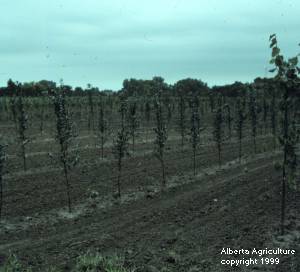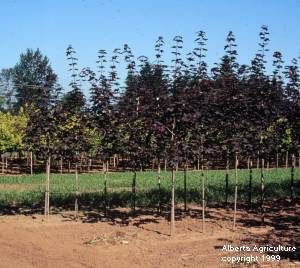| | Most of Alberta's woody plants are produced in the field with a smaller portion being grown in containers. Proper management is always important to produce quality. There are a number of advantages and disadvantages associated with field production.
Advantages
- Well managed plants generally overwinter well.
- Maintenance and pruning can be done during late winter when container-grown plants are still under winter protection.
- Growth is not limited by the size of the pot.
- Some natural fertilizer and water reserves exist in the soil.
- Trees do not generally require staking.
- Usually higher returns over investments are realized.
Disadvantages
- Typically a longer time period is required for trees to grow to a saleable size.
- Trees must be balled and burlapped or containerized for sale.
- Harvested trees have a short window of time for harvest, storage, and sale.
- Field-grown nursery stock requires more land.
- A significant amount of soil is harvested with each tree.
Planting plans
When organizing a planting plan, a grower must consider spacing within and between rows as well as the organization of the rows with respect to species. A well planned nursery should provide efficient use of land and equipment while producing a quality, uniform product. Although spacing requirements may vary somewhat for different species, a standardized plan can reduce costs through efficient use of equipment. Determine a harvesting schedule that leaves a sizable block to prepare for future planting instead of several small blocks which are an inefficient use of equipment, materials, and land.
A row spacing alternating between 3.5 m and 2.5 m between rows and with 1.5 m between trees, within rows is commonly used. This allows large equipment through for digging in the wide row and smaller tractors, in the narrow row. The average between row spacing of 3 m and the within row spacing of 1.5 m will produce about 2200 trees per hectare or about 900 trees per acre.

Clean cultivation between tree rows.
Between row cropping
To prevent soil erosion and pest problems, the areas between rows of trees may be seeded down with a green manure crop, such as fall rye, or a more permanent crop such as a turf grass mix. There should be about a 1 m clean strip around the tree. The type of crop used should be suitable to the environment (eg. drought tolerant in Southern Alberta) and require minimal maintenance. This will reduce cultivation, weed control applications, and will allow equipment onto the field earlier in the season. This crop will compete for available water and may not be suitable where irrigation is not available.

Grassed alleyways between trees.
Green manure and organic matter
After trees have been harvested the field should go through a restoration period of at least one season. To add organic matter, improve drainage and improve soil fertility, green manure crops are grown then plowed down while still green. Indian Head lentils, winter wheat, or barley are examples of crops that can be seeded and before seed heads appear, mowed or cultivated into the soil.
Animal manure and compost are also good sources of organic matter and fertilizer and can be worked into the soil during the season preceding planting. Caution should be taken that the manure or compost is well aged to avoid competition for nutrients and when the manure is adequately composted, many weed seeds are destroyed.
Fertilizing
Fertilizer applications on field-grown material should be based on the amount of available nutrients shown in the soil tests. Nitrogen can be most influential on plant growth and can be applied in the spring and early summer or late fall. Applying late in the summer (mid-July to early September) may cause the tree to be actively growing when it should be hardening off for winter dormancy. Active growth in late summer or fall will result in winter damage. Good recommendations for fertilizer applications in Alberta do not exist; however, field experience indicates that soil can be brought up to about 84 kg/ha (75 lb/ac) nitrogen and phosphorus and 168 kg/ha (15 lb/ac) potassium. Fertilizers may be broadcasted over the area or banded along the tree rows. Banding is a more efficient use of fertilizer and is recommended.
Irrigation
Trees in the field are usually irrigated using an overhead sprinkler system but increasingly trickle irrigation is being used. Trickle irrigation uses water more efficiently, is easier to work around, and places the water next to the tree and not in between the rows where it is not desired. Trickle irrigation requires low pressure pumps, excellent filtering systems, and pressure regulators to reduce clogged emitters and blowouts. Both trickle and overhead sprinkler systems require monitoring to ensure sprinklers and emitters are working properly. Irrigation dealers and suppliers can help when designing the irrigation system.
Pruning requirements
To produce a uniform quality tree or shrub that will conform to the industry standards, routine pruning is required. Pruning of most species can be done in winter and early spring. For further information see Pruning in Alberta, Canadian Standards for Nursery Stock, and Tree Maintenance (Appendix A).
Plant choice
Selecting the tree species to grow requires careful evaluation. The decision should be based on the market being targeted. Trees planted in commercial landscapes, for example, may be different species to those in residential landscapes. Survey landscapers and garden centres to find what is selling. Drive through newer neighbourhoods and note what is planted.
Choose species that are well adapted to the area being served. Borderline hardy species may have a small part of the market and production of such should be limited and guarantees may need to be adjusted. Consider the method of harvesting when choosing plants. Deep rooted species, such as oak, may not survive an undercutting of the roots. Investigate the soil type and pH of the nursery site as this may limit the choice of species that can be grown. Evaluate the length of time for the species to reach marketable size, compared with its market value to determine cost of production.
In Alberta, the majority of nurseries producing trees and shrubs start with liner stock, usually purchased from the interior of B.C.,Washington, Oregon, or points east. A 'liner' is a young plant (one or two years old) sold to be 'lined out' in the field. The material is ordered early in the fall of the preceding year and shipped in the spring for planting. The trees are typically grown on for three or more years, then are harvested for sale. Landscape Alberta Nursery Trades Association (LANTA) has produced a plant supply guide, LANDX (Appendix A), listing nurseries in and out of province that supply Alberta nurseries. The British Columbia Nursery Trades Association (BCNTA) have published a similar guide called The Directory and Buyers Guide (Appendix A). |
|